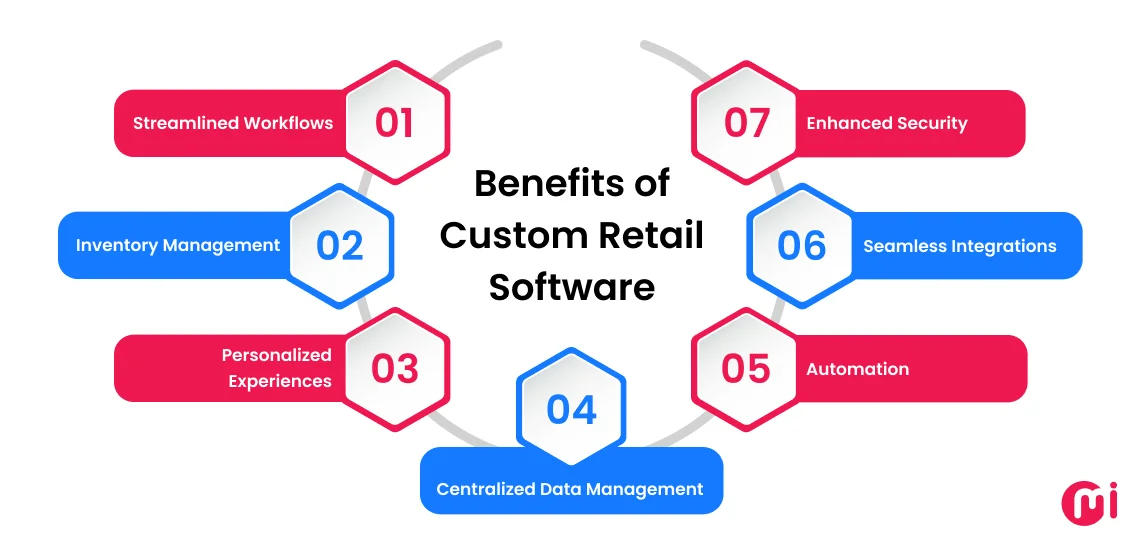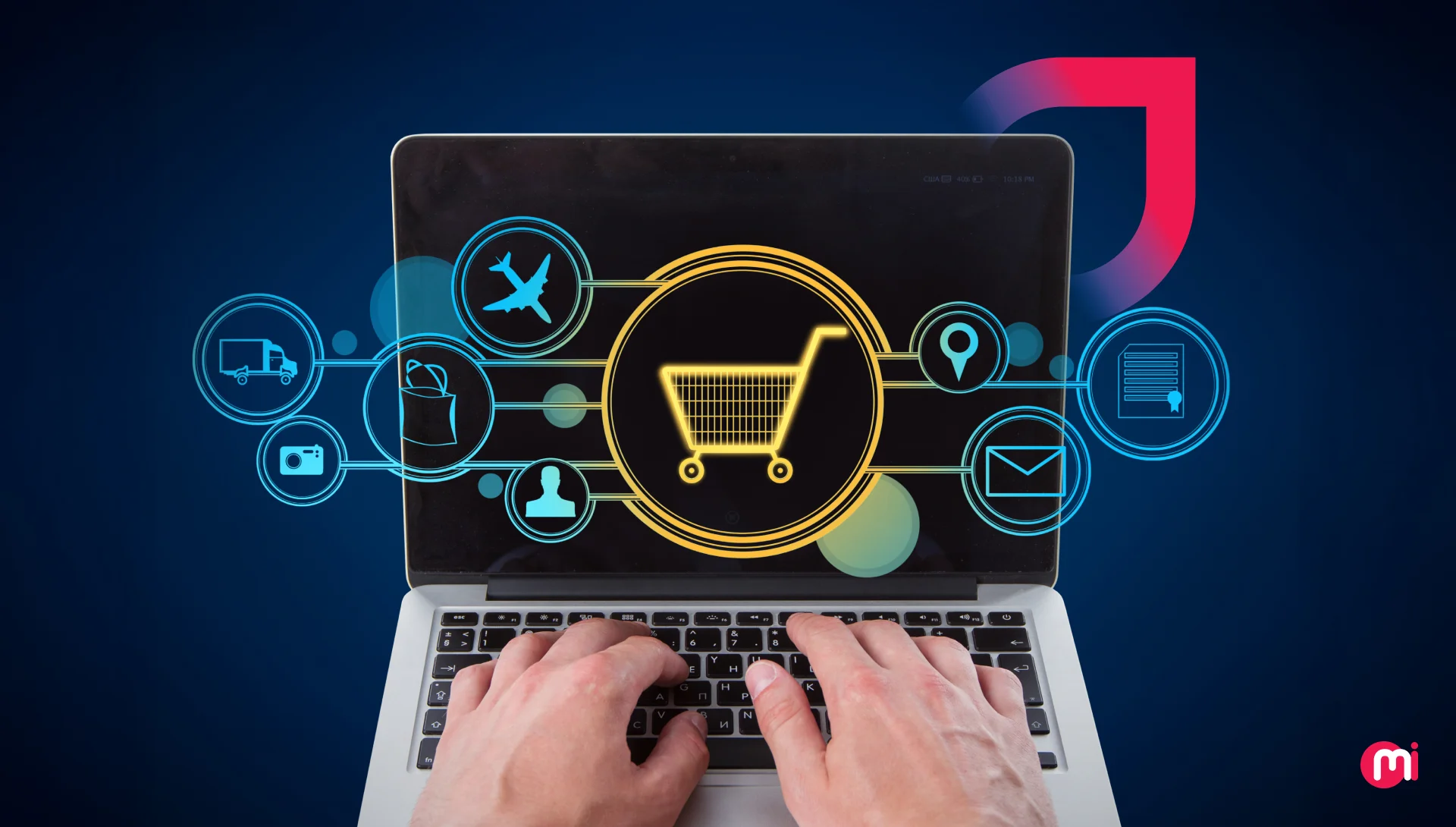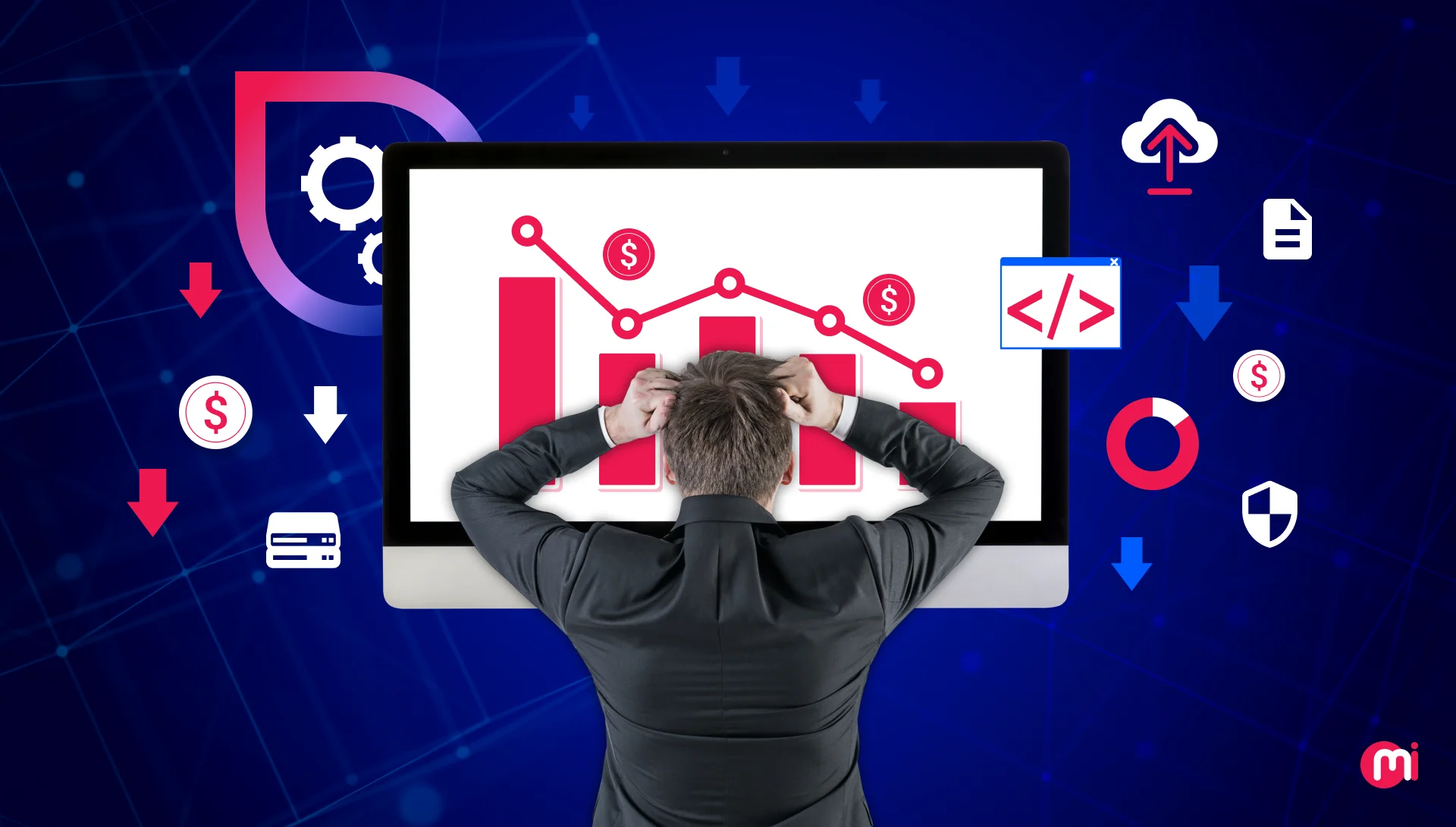End-To-End Retail Software Development Guide For Modern Businesses
- Software
- August 25, 2025
Retail businesses today use software solutions to improve profitability, efficiency, and customer retention rate. From streamlining operations to enabling data-driven decisions, custom retail software gives brands the competitive edge they need in an evolving market. This blog discusses the significance of retail software development while providing insights into its types, benefits, development process, cost, and other important aspects.
Retail is moving faster than ever, and software is at the center of it all. Harvard Business Review highlights that companies unwilling to adapt to digital shifts risk ending up like once-iconic brands that faded out of relevance.
The impact is clear, as the investment in retail software development reflects a real transformation. From global chains to growing D2C brands, businesses are using purpose-built software to stay ahead, automate backend tasks, enable real-time data access, and create connected journeys across every channel.
So, if retail growth is your goal, ai in customer service and software should be at the center of your strategy. From managing inventory and streamlining sales to delivering personalized customer experiences, the right retail software, enhanced by ai customer service, does more than support your business; it drives it.
This blog reveals everything you need to know about retail software development, from key types and benefits to the development process and real-world impact.

Business Benefits of Custom Retail Software

Custom retail software streamlines workflows, helps with inventory management, personalizes experiences, and centralizes data to make smarter decisions. With a tailored solution, retailers can automate processes, integrate third-party services, and ensure uptight security. Here’s a closer look at the advantages it brings:
Streamlined Workflows
Custom retail software helps simplify daily operations by automating routine tasks and reducing manual errors. Teams can manage orders, sales, and staff more efficiently, saving time and improving accuracy.
Inventory Management
With built-in inventory tracking, retailers can monitor stock levels in real time, set reorder alerts, and reduce the chances of overstocking or running out of popular items. It keeps your supply chain moving smoothly.
Personalized Experiences
Custom software development solutions allow you to tailor promotions, recommendations, and communication based on customer preferences and shopping history, creating a more engaging and relevant experience for every user.
Centralized Data Management
All customer, sales, and inventory data is stored in one system, making it easier to access insights and keep everything in sync. This supports better coordination across departments and smarter decision-making.
Automation
From billing and invoicing to order processing and reporting, automation reduces manual work and speeds up operations. It helps your team focus on tasks that drive growth instead of repetitive admin work.
Seamless Integrations
Custom software can easily integrate with tools like POS systems, CRMs, ERPs, and eCommerce platforms. This creates a connected ecosystem that improves workflow and reduces data silos.
Enhanced Security
Security features like role-based access, data encryption, and secure payment handling keep your business and customer information protected. It ensures compliance and builds trust with users.
Also Read: Guide to Scalable Warehouse Management System.
Types of Retail Software Used in the Retail Industry
Types of retail software include retail management, Point of Sale (POS), CMS, ERP, inventory management, omnichannel retail, virtual try-on, retail analytics and forecasting, and AI-automated self-checkout software. Here’s a detailed breakdown of types of software for retail businesses can build:
1. Retail Management Software
Retail management software functions as the central hub that connects sales, inventory, and operations into one streamlined system. It reduces fragmentation by giving retailers real-time control over pricing, promotions, staff, and performance across locations. This type of software is essential for maintaining consistency and operational efficiency at scale.
2. Point of Sale (POS) Software
POS software handles transactions at checkout, combining payment processing, billing, and inventory updates in real time. Modern POS systems also support digital payments, customer profiles, and integration with loyalty programs for a smoother in-store experience. Mobile POS and contactless payments help retailers adapt to customer experiences and speed up the purchase journey.
3. Customer Relationship Management Software (CRM)
Customer data is one of the biggest drivers of retail personalization. A Customer Relationship Management (CRM) software enables retailers to gather and utilize customer behavior, purchase history, and preferences to tailor marketing and service.
When you create a custom CRM aligned with your business model, you open the door to better retention, smarter segmentation, and higher lifetime value. Effective CRM solutions also provide actionable insights that help drive strategic decisions and foster stronger, long-term customer relationships.
4. Supply Chain Management
Supply chain management software helps retailers efficiently manage the flow of goods from suppliers to customers. It provides visibility into inventory levels, demand forecasting, supplier performance, and logistics operations.
Many retailers now leverage AI in supply chain management to optimize procurement, transportation, and order fulfillment, reducing costs and preventing stockouts or overstock situations. An effective SCM system ensures that products reach the right place at the right time and is critical for operational efficiency, customer satisfaction, and scalable growth in a competitive market.
5. Warehouse Management Software
Warehouse management software streamlines all operations within a warehouse, from receiving and storage to picking, packing, and shipping. It provides real-time tracking of inventory, automates order processing, and enhances space utilization. It also integrates with other retail systems, such as SCM and POS, ensuring accurate inventory data across channels.
For retailers, WMS improves operational accuracy, reduces order fulfilment times, minimizes human errors, and enhances overall supply chain efficiency, making it an essential component of modern retail software ecosystems.
6. Enterprise Resource Planning (ERP) Software
ERP systems unify various business functions like finance, logistics, supply chain, HR, and inventory into one system. For retail, ERP software solutions ensure all departments operate with up-to-date information, increasing coordination and reducing inefficiencies.
By using AI in ERP, retailers can automate forecasting, optimize procurement, and enhance decision-making with real-time insights. This integration minimizes delays, reduces operational costs, and improves end-to-end visibility across the business.
7. Inventory Management Software
Managing stock efficiently is key to avoiding lost sales or overstocking. Inventory software provides real-time tracking, automated restocking, and accurate forecasting across multiple locations.
By leveraging AI in inventory management, retailers can maintain optimal stock levels, reduce shrinkage, and respond quickly to demand shifts, especially during seasonal peaks or high-volume periods.
8. Omnichannel Retail Platforms
Omnichannel retail platforms bridge the gap between online and offline shopping experiences, enabling customers to browse, buy, and return products across multiple touchpoints seamlessly.
By integrating mobile apps, e-commerce websites, in-store systems, and social media channels, these platforms ensure a unified experience through features like shared shopping carts, cross-channel promotions, and real-time inventory updates.
As part of the broader digital transformation in retail, omnichannel solutions help retailers deliver convenience, personalization, and consistent engagement at every stage of the customer journey.
9. Virtual Try-On Software
This software uses AR to let customers visualize how products look or fit in real-time, be it clothing, eyewear, or furniture. It reduces hesitation, enhances confidence, and lowers return rates. Retailers benefit from higher conversions and a cutting-edge brand image that appeals to experience-first shoppers.
10. Retail Analytics and Forecasting Software
Advanced analytics turn sales, customer, and inventory data into insights that inform pricing, promotions, and planning. Forecasting tools help predict demand, optimize assortments, and identify underperforming SKUs. When used well, this software gives retailers a clear strategic edge, especially in fast-changing markets.
11. AI-Automated Self-Checkout Software
This smart checkout solution uses vision and sensor technology to eliminate manual scanning and waiting in lines. It enhances customer satisfaction through speed and convenience while reducing reliance on staff. For retailers, it offers smooth operations, lower labor costs, and improved customer service.
How to Build a Retail Software: A Step-by-Step Process
Custom retail software development requires a well-defined process that aligns with your business model, customer expectations, and long-term growth. Each step, from setting clear goals to ongoing support, plays a critical role in ensuring the software delivers value from day one and adapts as your business evolves. Below is a step-by-step look at the retail software development process:
1. Assess Retail Goals & Market Demands
Identify your business needs, customer expectations, and competitive gaps. Understanding what your retail software must solve sets a strong foundation for the retail software development process. Outline current operational plan points and future growth plans.
Map out your project and think of your vision and objectives during this software discovery phase, as it helps align every stakeholder and development around clear goals and priorities from day one.
2. Outline Core Modules & User Flows
Outline the core modules your retail software needs, like inventory, POS, CRM, or analytics, based on your operations and customer journeys. Map user flows that reflect real interactions across in-store and online channels.
This step ensures your software structure supports both internal efficiency and external engagement. Clear, well-defined flows also reduce confusion during development.
3. Select Scalable & Secure Technologies
Choose frontend and backend development technologies that ensure your retail software can scale with your business and remain secure under growing user demands. Opt for modern frameworks, robust backend systems, and cloud infrastructure that supports flexibility. Prioritize tools that allow for faster integrations and real-time performance.
Also, leverage AI in retail software or other emerging technologies, as they will give your business a competitive edge over others and set the tone for long-term reliability and agility.
4. Craft a Dynamic Design Experience
Decide whether you want a human-centric or user-centric design approach and which one best aligns with your business goals. The choice depends on the scope of your software, the target audience, and the type of interactions you want to prioritize.
User-centric UI UX design approach focuses on the end user’s immediate interactions with the software. Prioritize intuitive navigation, responsive layouts, and user flows that minimize effort and reduce confusion.
This approach works best when your primary goal is to enhance task efficiency, improve usability, and ensure quick adoption among employees or customers who will directly use the software daily.
Meanwhile, human-centric UI UX design considers broader human needs, emotions, and context beyond mere task completion. It’s ideal when your software must engage users on an emotional level, support decision-making, or influence behaviors, such as loyalty programs, personalized shopping experiences, or training modules. Human-centric design emphasizes empathy, storytelling, and user satisfaction as well as efficiency.
By understanding the purpose of your retail software and the audience it serves, you can choose the design philosophy that delivers the best experience and long-term adoption.
5. Develop Frontend and Backend of the Software
Create a software prototype and collect user feedback before moving to the retail software development process. After refining the prototype, ask your team to build the frontend and backend in sync to ensure your retail software works smoothly across devices and platforms.
The frontend should deliver a fast, intuitive experience for users, while the backend must be robust enough to handle large datasets, real-time updates, and complex integrations.
Use scalable frontend frameworks and modular architecture to keep your system stable when your business grows. A well-structured backend also supports better data security and performance at scale.
6. Run Comprehensive Quality Testing
Hire QA engineers to run quality testing to make sure your retail software performs reliably under all conditions. Test every feature, from checkout flows to inventory updates, across different devices, operating systems, and user scenarios.
Identify bugs, usability issues, and performance bottlenecks early to avoid costly fixes later. Prioritize functional, security, and usability testing to ensure the software is market-ready and meets user expectations.
7. Launch & Monitor Performance in Real Time
Launch your retail software with a clear rollout plan, ensuring minimal disruption and maximum visibility. Once live, track key performance indicators like load time, transaction success rates, and user engagement in real time.
Use this data to catch potential issues early, optimize system responsiveness, and ensure smooth day-to-day operations. A performance-driven launch helps you validate assumptions and adapt quickly based on live user behavior.
8. Refine Features & Support Continuous Growth
Track user behavior, gather feedback, and align updates with evolving business goals. Improve usability, boost performance, and release features that solve real challenges. Continuously refine the product attributes as your retail operations expand and shift.

How Much Does It Cost to Build Retail Software?
On average, a custom retail software solution can cost anywhere from $30,000 to $200,000 or more. However, the cost to develop retail software can vary widely based on its complexity, features, and the software development company you choose to work on the project.
Here’s a basic estimation of software development cost for the retail industry:
| Type of Software | Estimated Cost | What it Includes |
| Basic Retail Software | $30,000 to $50,000+ | Simple POS or inventory tools |
| Mid-Level Solutions | $50,000 to $80,000+ | Multi-store, integrated CMS, analytics |
| Enterprise-Grade Platforms | $80,000 to $200,000+ | ERP integrations, omnichannel features, AI modules |
Other factors that influence cost include UI/UX design complexity, third-party integrations, backend infrastructure, security features, and post-launch support. For an accurate estimate, reach out to a reliable software development company after defining goals, must-have features, and growth plans.
Factors to Evaluate Before Hiring a Tech Partner for Retail Software Development
When choosing a tech partner for retail software development, focus on their industry experience, technical expertise, customization capabilities, project management process, client testimonials & case studies, security practices, and ability to manage complex projects efficiently. Make sure their pricing is transparent, their delivery is reliable, and they can scale alongside your growth.
Industry Experience
Hire software developers from a well-known company with prior experience in the retail domain. Your developers should be familiar with retail workflows, software development trends, and user behaviors. These aspects will reduce the learning curve and speed the development process.
Technical Expertise
When evaluating providers, look for those who have a strong command of modern technologies, including cloud infrastructure, scalable architecture, and retail-focused solutions such as POS systems, AI tools, and advanced analytics engines.
Equally important is their adherence to software design principles which ensure that the solutions they deliver are reliable, maintainable, and adaptable to evolving business needs.
Customization Capabilities
Every retail business is different. Choose a company that offers tailor-made solutions instead of cookie-cutter templates, so your software aligns perfectly with your operational model and growth goals.
Cost Transparency
Conduct market research to know the nominal prices that software development companies are charging. Ask for clear cost breakdowns and avoid dealing with companies that have hidden charges in their contract. Seek transparency in pricing, as it will help you balance budget with functionality.
Project Management Process
Hire a software development team that follows agile software development methodology or any other structured project methodology that suits your project type. A structured approach will ensure timely updates, regular feedback loops, and quick iterations. Look for teams that prioritize collaboration, milestone tracking, and open communication.
Client Testimonials & Case Studies
Review real-world case studies and client feedback to assess credibility. Past successes with similar retail clients can be a strong indicator of the partner’s ability to deliver results.
Security Practices
Retail software handles sensitive customer and business data. Verify that your tech partner follows proven software development practices, strong security protocols, encryption standards, and data privacy regulations to protect your ecosystem.
Post-Launch Support
A reliable partner doesn’t disappear after product deployment. They stay with you for software application maintenance whenever required. You must ensure your tech partner will assist you in performance monitoring, bug fixing, and feature upgrades when you want to scale your business.

Real-World Success Stories of Businesses That Implemented Retail Software
Many leading businesses, including Walmart, Panasonic, and Sephora, have leveraged custom retail software to elevate operations, enhance customer experiences, and drive measurable growth. These success stories show how the right technology investment can help scale and build customer connections across retail channels.
1. Walmart
Walmart transformed retail operations by deploying AI-powered inventory software and advanced analytics, leading to a 30% reduction in stockouts across stores.
Walmart also improved inventory turnover by 12%, cut supply chain costs by $200 million, and enhanced demand forecasting using machine learning-driven insights. Their success shows how retail businesses can leverage smart software to enhance visibility, boost efficiency, and scale with precision.
2. Panasonic
Panasonic upgraded its retail operations using Electronic Shelf Label (ESL) technology and AI-driven supply chain tools, resulting in a reduction in pricing errors and faster price updates across stores. They also integrated real-time inventory and supply chain software, reducing distributor stock by over 20% while maintaining a 99% delivery rate.
These investments in retail software enabled smoother operations, reduced manual tasks, and empowered staff to focus on customer experience. Panasonic’s journey shows how strategic retail software not only streamlines operations but also creates measurable business impact.

3. Sephora
Sephora has embedded AI and AR technologies into its customer experience through tools like Virtual Artist, enabling users to virtually try on makeup before purchase. This innovation led to a 112% increase in conversion rates, a 28% reduction in product returns, and a 9.2× surge in virtual try-ons year-over-year.
Their AI-powered software personalization now drives approximately 70% of total sales, showing how deeply Sephora integrates retail software development into its business.
Final Thoughts
Retail software moves with your strategy as your business scales and touches new heights of growth. In an environment where speed, personalization, and control define market leaders, it becomes your edge. It is an infrastructure that drives margins, unlocks scale, and turns real-time insights into business action
Build Smarter, Scalable Retail Software with MindInventory by Your Side
MindInventory is a trusted retail software development company, helping brands stay competitive in today’s fast-moving digital retail space. Our experts leverage next-gen technologies like AI, cloud-native architecture, predictive analytics, and scalable microservices to build a retail management platform, POS system, CMS, ERP, omnichannel commerce solution, and other types of retail software.
Our retail and e-commerce solutions are crafted to deliver on three fronts: agility, efficiency, and growth. Our development approach is rooted in deep technical expertise and a forward-thinking mindset.
We’ve helped enterprises optimize supply chains, reduce operational bottlenecks, boost customer retention, and increase revenue through strategic, tech-powered innovation. When you work with MindInventory, you gain more than a vendor; you gain a technology partner who understands the pace of retail and knows how to build software that gives you a measurable edge.
FAQs on Retail Software Development
Retail software is a digital solution designed to help businesses manage and streamline their retail operations. It supports functions like sales processing, inventory tracking, customer management, and reporting. Whether it’s for physical stores or online platforms, retail software improves efficiency, accuracy, and overall customer experience.
Retail software development is the process of designing, building, and deploying custom digital solutions tailored to the needs of retail businesses. It involves creating applications or platforms that support sales, inventory, customer engagement, analytics, and more. This software optimizes retail operations, enhances user experiences, and enables businesses to adapt to changing market demands.
Real-life examples of businesses that used retail software include Walmart, Starbucks, Nike, Zara, Sephora, IKEA, Target, H&M, and Walgreens. These brands showcase how the right retail software can support growth and deliver seamless retail experiences.
The time to build a retail software solution typically ranges from 6 months to 2 years or more, depending on its complexity, features, integrations, and team size. A basic solution with core features can be developed faster, while enterprise-level platforms with advanced functionalities and multi-system integration take longer.













